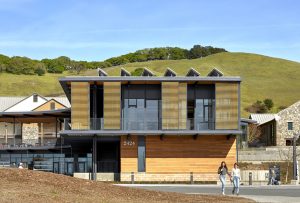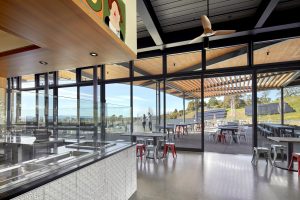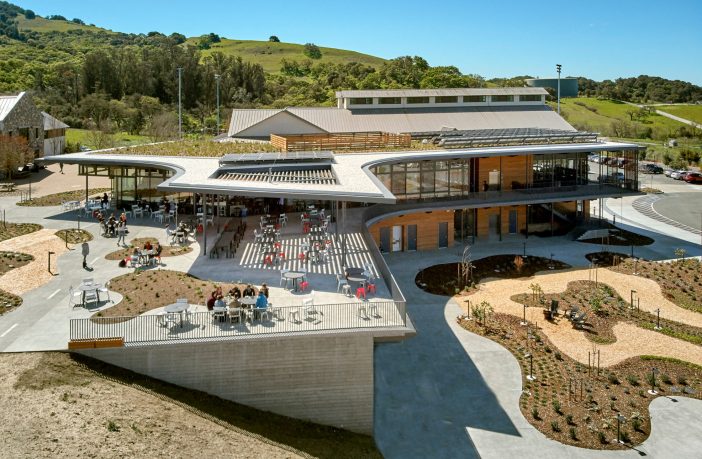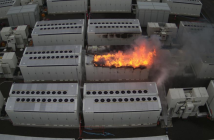- The Sonoma Academy has a symbiotic relationship between the school community, the natural environment, and the regional economy.
- Sliding screens, automated shades, visible radiant system controls, and deep overhangs relay how the building responds to climate.
- Regionally-sourced low carbon block, ceramic tiles, reclaimed beams, and exterior and interior sliding are paired with regionally-made lamps and furniture to celebrate community.
The Sonoma Academy is a high school (college) situated in Santa Rosa in the USA. It has a 34 acre campus but it is the Janet Durgin Guild & Commons centre that has everyone talking. The centre houses maker and digital media studios, student support services, indoor / outdoor dining, an all induction commercial kitchen, and a teaching kitchen / meeting room that overlooks the school’s productive gardens and the maker classroom patio.
Sonoma Academy’s guiding principles of creativity, inclusive community, exploration, and innovation, coupled with a humanistic approach to education, were the inspiration for the two sweeping floors that begin in the heart of the campus and face the horizon with amazing views of Santa Rosa.
Sliding screens, automated shades, visible radiant system controls, and deep overhangs relay how the building responds to climate. Regionally-sourced low carbon block, ceramic tiles, reclaimed beams, and exterior and interior sliding are paired with regionally-made lamps and furniture to celebrate community.

Pic Janet Durgin Guild & Commons at Sonoma Academy
The living roof attracts pollinators, houses photovoltaics, and connects to tiered planters that filter greywater and stormwater for reuse. The project is seeking LEED Platinum, ZNE, WELL Education Pilot, and LBC Petal certification.
In two sweeping floors, Durgin Guild & Commons provides the tools for students to become innovators and invites the community to participate in the academic process. The Guild, on the lower level, blends a mix of maker spaces — wood assembly, metal shop, digital media, and robotics — into an innovation space designed to adapt over time. The Commons, on the upper floor, serves as a multi-use dining and events center, hosting daily lunches and academy events for students to dine, socialize, or spend a quiet moment alone.
The design team addressed Sonoma Academy’s core values of engagement, wellness, inclusivity, and sustainability by embedding indoor / outdoor learning into the DNA of the new building. The Commons’ generous operable windows pull in sunlight and fresh air while sliding doors allow for the students to spill outside under the patio’s slatted roofs.

Pic Janet Durgin Guild & Commons at Sonoma Academy
The lower level Guild incorporates large garage doors opening out onto a patio, garden, and surrounding outdoor teaching areas. The garden acts as classroom, park and gallery in which making with tools, nature, and technology blend. Further reinforcing a nature connection, locally sourced reclaimed wood is integrated throughout — interior walls, farm tables, benches — with more than 80% of the interior spaces having natural light.
Janet Durgin Guild & Commons demonstrates the symbiosis between the school community, the natural environment, and the regional economy. Highly engaged parents and stakeholders led “coffee chats,” driving the conversation about sustainable goals and issues of equality. Sonoma County-based craftspeople provided much of the materials, reducing material transportation costs while demonstrating local resourcefulness in the use of low-carbon earth blocks.
A farm-to-table program is part of the curriculum and daily life — educating students about equity issues and the environmental impacts of food production and distribution within the regional economy while providing them with healthy meals. Janet Durgin Guild & Commons is designed to be a literal representation of the school’s mission, underscoring the belief that schools can be incubators for unbridled inventiveness and pathways to a more sustainable future.
Author: Bryan Groenendaal
Source: WRNS Studio
















